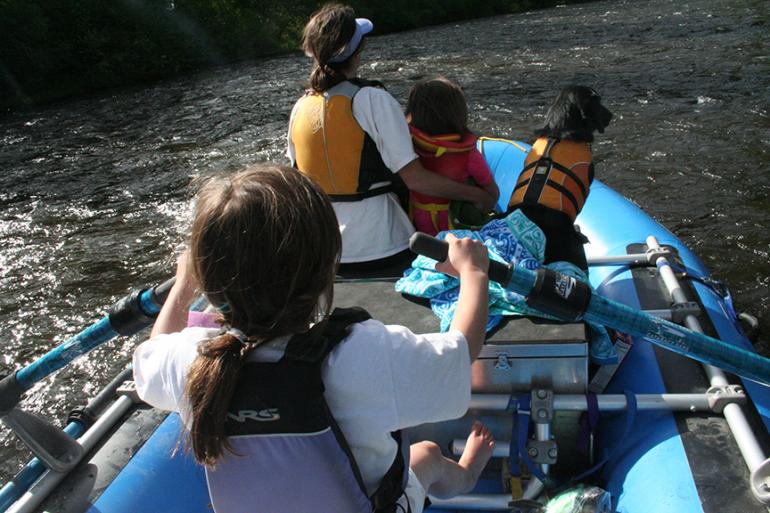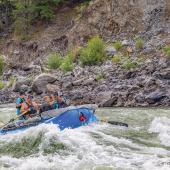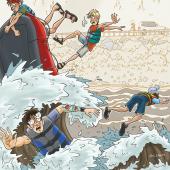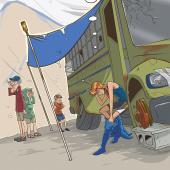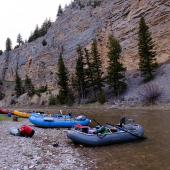Family Floating
“Dad, there’s a rock at the bottom of the ‘V,’” said Jesse, age seven. She knew that we would follow the deeper, glassier water into the steeper gradient. She made sure that we avoided the boulder as well as a likely corresponding hydraulic.
It was our family’s first Gallatin River outing. In lower August flows, we put in below Mad Mile, mindful of both natural and human-made hazards. We were joined by friends and our lab/basset hound Millie, donning an orange life vest. The shallow water combined with numerous boulders called for a fair bit of maneuvering. With Jesse pointing the way, sister Remi, age five, jumped in my lap, grasping an oar in each small hand. In that way, we ferry left or right, split two boulders, or run riffles—and, for our daughters, it’s all good.
Home Rivers
That day completed our cycle of floating trips on our “home rivers”: the Madison, Yellowstone, Jefferson, and Gallatin. We never would have enjoyed a stretch of the Gallatin if our family had not developed skills and experience on other local rivers. Jesse’s first float at 18 months took her on the downstream sections of the Madison leading to the river’s meeting point with the Missouri at Headwaters State Park. When we bought our 15-foot raft three seasons ago, the maiden voyage was on the Madison upstream of Ennis. At the launch, the boat was christened, “Hokahe,” a Lakota exhortation that can be translated as “let’s go!”
Over time, primarily on Class I and II waters, we covered 60 miles of the Yellowstone through Paradise Valley and downstream from Livingston, various segments of the upper and Lower Madison, the Jefferson in the canyon below Cardwell, and stretches of other rivers. We watch the kids grow, learn to read water, develop rowing and paddling skills, float with life vests while maintaining proper river position, show love and respect for waterways and surrounding nature, and have fun. As parents, we build our skills and develop what we believe are the safest ways to float and river camp with our kids. This happens with informal and formal training, direct—and sometimes humorous—conversations between Mom and Dad, close review of maps and guidebooks, and the incredible river access near our Bozeman home.
Summer 2012 marked Jesse and Remi passing 500 total river miles on 10 combined rivers, ending with the Gallatin. Above sounds of rushing water, we talked on the Gallatin’s edge about the rivers our family explored. The older daughter quickly listed 9 of the 10 rivers. The younger daughter spoke of Lewis and Clark; perhaps she remembered her parents talking about the naming of the Gallatin or the sisters’ excitement floating the Jefferson by Antelope Creek where Sacagawea once camped. I beamed with her reference to the continental explorers, some of whom—traveling with a child—camped on the East Gallatin, crossed Bozeman Pass, built canoes near the mouth of the Stillwater, and floated the Yellowstone, which are places also visited by Jesse and Remi.
Flower and Pinky
Below the Yellowstone’s bend downstream of Livingston, Remi and Jesse found a garter snake, naming it “Flower.” The following season a garter snake appeared in our raft after a night of camping along the North Fork of the Flathead. The girls were thrilled, and Remi named this snake, “Pinky.” She exclaimed, “I now know two snakes in Montana: Flower and Pinky!”
The girls met Flower and Pinky because of time spent on and near water. Experiences gained over the seasons on various river sections in contrasting weather, and on slow and fast currents flow together. My wife and I believe these experiences contribute toward the overall development, values, and perspectives of the kids, as well as toward happy and loving connections among family members and friends. Mom and Dad will always remember that once their children gently played with a garter snake on the Yellowstone’s yellow banks.
Flower and Pinky aren’t the girls’ only river companions. From the water and the shoreline, wildlife sightings have also included black bear, beaver, otter, bald and golden eagles, osprey, wild turkey, mergansers, a great horned owl, cliff swallows, and a deer swimming from one bank to the other.
Trout are sometimes seen up close on Jesse’s fly-fishing line. With patience, Jesse also encourages her parents to fish. After observing her dad zing a fly in too many directions, Jesse will politely recommend more practice before further attempts.
“Bat Ears!”
Millie loves to jut her canine nose into a soft upstream breeze. When conditions are right, the air currents give loft to her ears. This look is popular with Jesse and Remi, a chorus of “bat ears!” rising from the boat as the wind holds Millie’s ears aloft.
Millie has 330 river miles under her collar. For our daughters, the dog is a playmate in camp, a comfort in the tent, and a kindred spirit on the water. Millie rode standing on the raft’s outer tube until the day we nudged a boulder in a pool-and-drop section. The resulting jar sent Millie into the water. She swiftly doggie-paddled to shore, followed a trail in the direction of the current, and rejoined us. She now securely centers herself on a dry box—lesson learned.
Golden Cottonwoods
A river season closes on a sunny and slightly brisk fall day along a low and quiet Yellowstone. The girls, using paddles for the first time, with grandparents by their sides, stroke past colorful, old trees. Winter comes with knowledge that the snow will replenish our home rivers in spring. Inside our heated home, Jesse sees a photograph of a river camp. Sentimentally, she comments, “That makes me homesick.” Her love for rivers and for being outside is music to her parents’ ears.
With snow melting, we prepare for a new river season. Together our family will square up to the first wave train, chanting, “One, two, three, Hokahe!”

